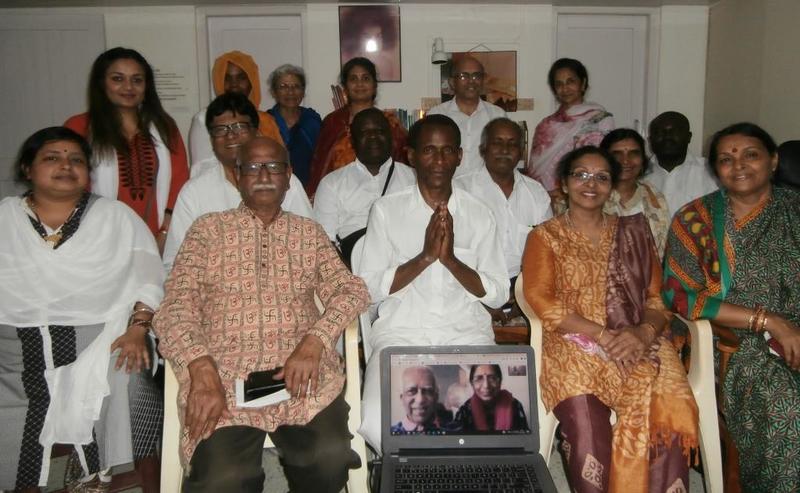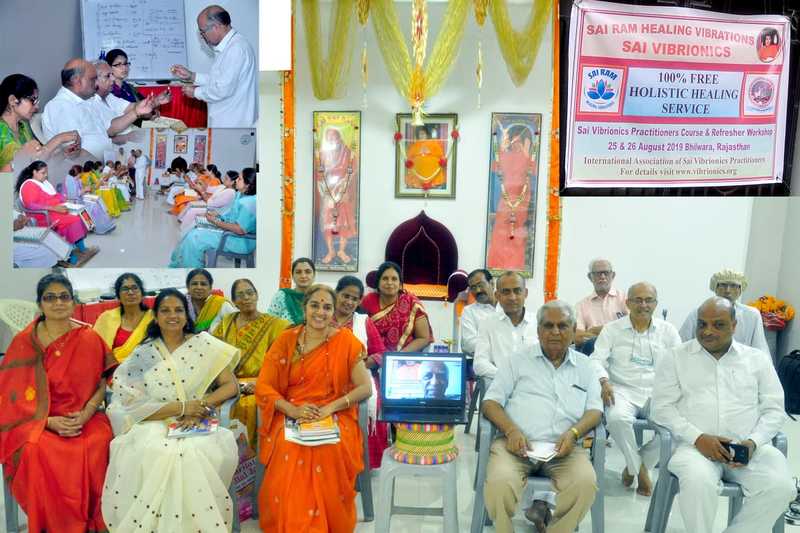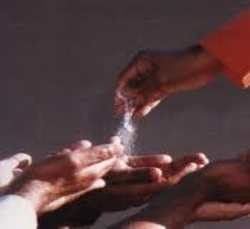In Addition
Vol 10 号 5
September/October 2019
-
Health Tips
Breathe right with awareness!
The breath teaches you Sohum all the time, 'so' when air is inhaled and 'hum,' when it is exhaled. This process has to be watched carefully. Here “so” relates to the Divine Principle and “hum” to ahamkara (ego). Thus, while Divinity enters into our body, ego leaves us. And that Divine Principle which has entered into our body must be held firmly in our system...” Sri Sathya Sai Baba.1-2
1. No breath, no life!
The first thing we did when we came onto this planet was to take a deep breath in and cry loudly, kick starting the lungs! The last thing we will do is breathe out and make others cry. In between these two major events, we breathe in and out, 24 hours a day, non-stop! Amazingly, we do not normally pay attention to our own breath!3
2. Let us know our breath
What is breathing? At a physical level, it is taking air into the lungs and then expelling it. Oxygen, vital for our survival, is taken in from the inhaled air and carbon dioxide is released while we breathe out. This happens automatically and quietly every moment. But, there is more to it than exchange of gases. Breath is like the invisible hand of the Divine, an unbroken string that goes on and on. So crucial is every breath that it ties us to our body. Without it, body will fall apart and life will cease in an instant.4-6
Process of breathing: Every function and every cell of the body needs a fresh supply of oxygen to produce energy. Inhaled air is first warmed and humidified, in tune with body temperature, and cleaned by the nose and lungs. Then the lungs supply this oxygen to the entire body and also get rid of the waste air, carbon dioxide, with the help of the circulatory system. Our brain constantly receives signals about the level of oxygen and carbon dioxide in the body and sends signals down the spinal cord to the diaphragm, a dome shaped muscle under the lungs, which contracts and relaxes during breathing. Sensors in the brain, blood vessels, muscles, and lungs adjust our breathing to changing needs depending upon our activity, situation, thought, and emotion.4,5,7
Normal breathing frequency: Normal respiration rate in adults at rest varies from 12 to 16 per minute (17280 to 23040 per day). In a newborn, this is 30-60 per minute which gradually decreases with age but it may increase after the age of 65. It also increases with activity and during illness at any age. It is one of the four vital signs, along with blood pressure, pulse, and temperature, commonly measured by medical practitioners during illness. Unhealthy lifestyle can make breathing faster thus paving the way for disease. Conditions that affect respiratory rate are anxiety, stress, emotions, asthma, pneumonia, congestive heart failure, or lung disease, use of narcotics, or drug overdose. Some experts consider slower breaths of 8-10 per minute as normal and best for overall health. We cannot measure our own respiration rate accurately since the moment we pay attention to it, our breathing would change and become slower and deeper. 8-12
Importance of nasal breathing: Normal breathing involves slow and steady nasal breathing in and out. Nose, unlike the mouth, is so structured as to eliminate the impurities and contaminants including deadly bacteria, aided by a gene in the body that stimulates the receptors of nose to that effect. Absorption of oxygen happens mostly on exhalation. Exhaling through nose is slower than through the mouth and enables the lungs to extract more oxygen for the body. It also ensures proper oxygen-carbon dioxide exchange and helps blood to maintain a balanced pH level.9,13,14
Risks of breathing through mouth: Carbon dioxide will get eliminated quickly due to which absorption of oxygen will slow down; symptoms of illnesses like high BP, asthma, and heart disease will worsen due to hyperventilation; health problems like shortness of breath, snoring, and sleep apnoea may arise as some important stages in the normal breathing process are bypassed. Continuous mouth breathing will open the way for bad bacteria to enter leading to infection. Also, it will weaken the lungs, heart, and brain over a period of time, by denying optimal oxygenation. One can break the habit by consciously breathing through the nose during the day and before going to sleep.9,13,14
Breathing through the mouth may be inevitable in some situations when the nasal passage is blocked or restricted or when the body has less oxygen. If a person is struggling to breathe, it is advisable to seek emergency medical help immediately. For a less serious problem with breathing consult a physician or a practitioner to set it right.
Alternate nasal breathing: There are certain things that anatomy does not teach. The passage of airflow in the two nostrils is asymmetrical in nature i.e. breathing through left nostril is different from breathing through the right nostril. This is due to tiny nerve endings at the base of the nose, connected directly to the brain and stimulated by smell and flow of air. Research studies have shown that a spongy tissue in one nostril swells and the tissue on the opposite side shrinks alternatively in a predictable pattern. This happens constantly, every one to two hours, known as infradian rhythm. It can be interfered with by emotional disturbance, irregular schedules of meal and sleep, and irritation of the nose due to pollution or infection.15-17
Impact of nasal cycle: It has been observed by yogis adept in the science of breath that while breathing through the right nostril, individuals become more alert, dynamic, and oriented towards the external world. That is, the left side of their brain becomes active. Similarly, breathing on the left side enhances creativity and calmer state of mind with propensity to look inward, indicating an activated right brain. Breathing exercises, like Pranayama help both nostrils to flow equally. Since this is conducive to meditative state, Pranayama precedes meditation sittings. Accordingly, in schools of yoga, breath is attuned properly before undertaking any activity. For example, opening the right nostril before eating to prepare the body for the active process of digestion and opening the left nostril before taking water and other fluids; to lie on one’s left side after a meal to stimulate the digestive process; to lie on the left side for 5-10 minutes while going to bed to create warmth and then turn to the right to relax oneself to fall sleep easily are all beneficial.15-17 Scientific studies have yet to catch up with these aspects. Some experiments have shown differential effects of uninostril and alternate nostril breathing on cardiovascular parameters and correlation with left and right brain activity. Also, regulated alternate nasal breathing can alter metabolism and have therapeutic value, especially in hypertension and pulmonary disorders.18-20
Disturbance in the nasal cycle can lead to disease according to yoga experts. If one nostril remains blocked, we will frequently experience pain and headaches. When the breath continues to flow in one nostril for more than two hours, it will have an adverse effect on our health. Longer the flow of breath in one nostril, more serious the illness. For instance, continuous right nostril breathing can lead to diabetes; long periods of activity of the left nostril may result in fatigue and reduced brain function and even asthma. These can be reversed with correct breathing through the other nostril under the supervision of an expert and then prevent recurrence by learning and practising alternate nasal breathing called svara yoga.16-17 Some studies have shown that changes in nasal airflow duration, pattern, and rhythm corresponded to various disease states in humans e.g., breathing through right nostril increased blood glucose level significantly and breathing through left nostril decreased it.21
Self-checking nostril dominance: We may self-check our nostril dominance by a simple technique of holding a pocket mirror against our septum and gently exhale. The mirror will show two puffs of condensed vapour from our breath. The one that takes longer to evaporate would indicate the dominant nostril. One may change the cycle by lying on the dominant-nostril side for 10 minutes to open up the opposite nostril and again check on the mirror to see the difference. In this way, one may experiment with oneself to enhance one’s awareness. But it is best to approach a competent teacher or a master to learn properly if one wants to be adept in it. The nasal cycle may vary from person to person and even at different times in the same person.22
3. Techniques of rhythmic breathing
The breathing we generally do is not breathing at all, according to experts. It is shallow breathing through the chest, upper part of the lungs but right breathing is within our power through attention, awareness, learning, and conscious practice.23,24
Simple breathing: It is best to breathe naturally, but consciously. A basic simple method is just to breathe in a measured way, in and out. That will harmonise the system. Later with practice one may mentally chant Om or Sohum or any sacred word of choice.23
Diaphragmatic breathing: If we lie on our back and place one hand on the chest and the other on the abdomen, we can observe the movement of our diaphragm while breathing naturally. As we breathe, let us visualize that we are inhaling air into the abdomen and pelvic area. If done properly, the hand on the chest should not move, while the hand on the abdomen should rise with the inhalation and fall with the exhalation. When we inhale fully, the diaphragm is pulled down while air is sucked into the lungs, causing the abdomen to move outward. When we relax and let go, the diaphragm slides back into its original position and air is expelled. If done regularly for 10 days with attention, movement of the diaphragm will get regulated and breathing using the diaphragm will become a habit. Practising a few minutes in the morning and evening will establish the habit and make it a meaningful part of our life.15,17
This can also be practised standing up, keeping the head, neck, and trunk straight, a hand on the abdomen and watch the movement of diaphragm. Gently push in and exhale, then let the abdomen come out and inhale. Fill the lungs, but don’t overdo it.15,17
Guidelines and advantages to remember: Breathe fully and smoothly, without jerks or sound, with awareness, in a relaxed way akin to a baby in deep sleep; not to create a long pause between inhalation and exhalation. If done correctly we will notice a sensation of coolness at the tip of the nostrils upon inhalation, and a feeling of warmth on exhalation. The lungs will get cleansed, the body will get cooled down and energised, and the internal stress response will get turned off producing profound relaxation. One can enjoy good health with heightened awareness and clarity in thinking.15,17
Caution: One can do simple breath-awareness exercises, but advanced techniques, especially those using breath retention, should be learnt and practised under the strict guidance of a competent teacher. Some practices are such as to befit only those on an ascetic path. There are different practices of breathing taught in different places and schools of yoga, depending on the stage and nature of one’s life. Some practices require altering one’s lifestyle substantially; if not done, it may not benefit at all, rather bring harm.25
4. Let our breath take us beyond!
Watching our own breath regularly with joy, awareness, and focus will gradually take us to the stillness and the truth within. “Love is My Form; Truth is my Breath; Bliss is My Food; My Life is My Message, Expansion is My Life..” sang Sri Sathya Sai Baba, to show the way! It is vital to know our breath, enjoy it with love, explore it, and just be with it. It will bring happiness in this life and, if pursued with undivided attention, help us transcend the elusive and illusive cycle of birth and death!
References and Links:
1. Sathya Sai Speaks, Vol11 (1971-72), Chapter 9, Step by Step, para7, http://www.sssbpt.info/ssspeaks/volume11/sss11-09.pdf
2. Sathya Sai Speaks, Dasara Discourse, 12 October 2002, Soham-the right sadhana, page 3: https://www.sathyasai.org/discour/2002/d021012.pdf
3. Ayurveda & Breath, a discourse by Gurudev Sri Sri Ravi Shankar, 1st edition, 2010, page 7, 23.
4. Breathing process: https://www.medicinenet.com/script/main/art.asp?articlekey=11056
5. https://www.nhlbi.nih.gov/health-topics/how-lungs-work
6. https://isha.sadhguru.org/in/en/wisdom/article/breath-bond
7. https://www.blf.org.uk/support-for-you/how-your-lungs-work/why-do-we-breathe
8. Respiratory rate: https://blog.epa.gov/2014/04/28/how-many-breaths-do-you-take-each-day/
9. http://www.normalbreathing.com/index-nb.php
10. https://my.clevelandclinic.org/health/articles/10881-vital-signs
12. Slow breathing good for health: https://drsircus.com/general/breathing-live-longer/
13. Nasal breathing: https://www.livestrong.com/article/255298-mouth-breathing-vs-nasal-breathing/
14. Nasal breathing: https://breathing.com/pages/nose-breathing
15. Alternate Nasal Breathing & Diaphragmatic breathing: A Practical Guide to Holistic Health by Swami Rama, The Himalayan Institute Press, Honesdale, Pennsylvania, 2005 edition, chapter 2, Cleansing, pages 19-22
16. http://www.onepointeded.com/alternate-nasal-breathing.html
17. Science of Breath, A Practical Guide by Swami Rama, Rudolph Balentine MD, Alan Hymes MD, Himalayan Institute of India, 2014 edition, p.62-67
18. Physiological and psychological effects of yogic nostril breathing: https://www.ncbi.nlm.nih.gov/pmc/articles/PMC4097918/
19. Benefits of Alternate Nasal Breathing: www.ncbi.nlm.nih.gov/pubmed/8063359
20. http://www.ijpp.com/IJPP%20archives/2005_49_4/475-483.pdf
21. Effect of disturbance in Nasal Cycle, a study: https://www.intechopen.com/books/pathophysiology-altered-physiological-states/alteration-in-nasal-cycle-rhythm-as-an-index-of-the-diseased-condition
22. Self-study on Nostril dominance: https://yogainternational.com/article/view/self-study-nostril-dominance
23. Techniques of breathing: Raja yoga, Conquering the internal nature, by Swami Vivekananda, chapter IV, the psychic prana, p.56 & Chap V, The Control of Psychic Prana, p.62-63, Advaita ashram Publication, Kolkata
24. Rhythmic breathing: https://www.artofliving.org/in-en/breathing-techniques
25. Caution: https://isha.sadhguru.org/in/en/wisdom/article/dont-school-breath
2. Awareness talks, South Florida, USA 11-14 July 2019
There was an awareness workshop held on 13 July, organised by Practitioners 11584 & 02787 at their home in Fort Lauderdale, South Florida. Many participants showed keen interest in taking vibrionics remedies and for possibly training to be practitioners themselves. This was preceded and followed by talks at both the Fort Lauderdale and Miami Sai centres where Dr Aggarwal shared his personal experiences with Swami including blessings and guidance given to him regarding the Vibrionics mission. Both meetings were well attended and a lot of interest was shown in learning more about vibrionics.

3. AVP workshop, Puttaparthi, India, 17-22 July 2019
Ten candidates (six from India, one each from Gabon (Central Africa), Benin (West Africa), South Africa, and UK) qualified as AVPs in this intense 6-day workshop. Four practitioners from India and abroad also participated to refresh and enhance their knowledge. The workshop conducted by the two senior teachers10375 & 11422, supported by a senior practitioner 11964, had inspiring and interactive sessions. Dr Jit Aggarwal gave some guidance through skype from US. The workshop also had invaluable inputs on effective case history writing by Mrs Hem Aggarwal. The highlight of this workshop was a shift in the teaching technique to a more interactive case study based method, rather than a chapter-wise presentation. The sessions were interspersed with demo and role-play by teachers and the senior practitioner as well as mock clinic in which the participants were encouraged to do role playing as patient and practitioner. A system of taking formal feedback from the participants about the format, content, and presentation aspects was also initiated. All the qualified AVPs took their oath before Swami with great enthusiasm, keen to start their practice.

4. Refresher Workshop in Hindi for VPs/AVPs, Bhilwara, Rajasthan, India, 25-27 August 2019
This three-day workshop was organised to reach out to practitioners in the remote areas of the State of Rajasthan in our drive to retrain the existing practitioners and bring them at par with the rigorous current standard of training. It took months of hard work by a senior teacher10375 together with two Bhilwara coordinators10461 & 10462 to organise this workshop. All the 14 (10 from Bhilwara and 4 from Jaipur) were computer non-savvy, did not undergo the mandatory e-course, and so arrangements were made to help them complete the course manually. It was conducted in Hindi by the senior teacher10375 supported by senior vibrionics practitioner11964 at the Sai Centre in Bhilwara, to update their knowledge.
The sessions covered the history and growth of vibrionics, responsibilities of practitioners, selection, preparation, and administration of remedies, and recording of patients’ history. The participants were happy that they could interact and get clarifications from Dr Aggarwal directly through a vibrant skype session. He emphasised on qualitative practice with sincerity, love and compassion, and professionalism.
The highlight of the workshop was many sessions of model clinic with lively role playing by the participants. This gave them an insight into the nuances of patient-practitioner interaction. Such was the interest that the sessions extended late into the evenings on all the three days and the participants were happy about it! This was supplemented by actual clinic every afternoon during which 30 patients were treated. That the workshop had resurged the practitioners’ energy and spirit was evident by the zeal shown by them. All took a pledge to take vibrionics to greater heights as a work entrusted to them by Swami.

Om Sai Ram
